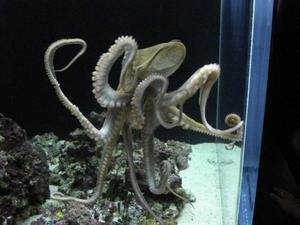Cephalopods are an intriguing family of mollusks to begin with; especially considering that cephalopod means “head-foot” when it’s translated. Imagine having your brains in your foot, and your body not consisting of much else. It does get even more entertaining than that when looking specifically at the Giant Pacific Octopus.
Just as the name states, they are massive. They are the largest of all octopi and measure between 10 and 16 feet on average and weigh between 22 and 110 pounds. Of course, Giant Pacific Octopi don’t start out this enormous, but therein lies another amusing fact. Octopus babies are slightly less than a quarter of an inch long when they hatch from their egg.
In order to reproduce, the octopus has to mate. This can be a serious problem when your species is known for cannibalism. The female is typically smaller than the male and must figure out if the male is trying to mate with her, or have her for dinner. The female puts out a scent that lets males know that she is ready to mate and not to eat her. When the female accepts the male, he uses his hectocotylus to deliver sperm packages to her. The hectocotylus is the third right tentacle on the male octopus.
The female then takes the sperm packages and stores them to use later after she has found a suitable home into which to have her babies. Once the female has found a den that she can close off using rocks, she climbs to the ceiling of the structure, and begins laying eggs. She lays them one at a time and fertilizes them as they are produced. The eggs are hooked together by strings that the mother uses to hang from the roof of the den. Each string has about 200 eggs, and she will lay about 57,000 eggs altogether.
The female cleans and watches over the eggs for the next 6 months or so until they hatch. When they are ready, she even helps the baby octopi get out of the eggs. Once the baby octopi, also called paralarvae, are free, they begin their long swim to the surface of the ocean. This is where the story gets a bit depressing because the mother will then crawl back out of the den she has made, and die.
The babies are carnivores and feed mainly on larvae and plankton. Eventually, as they grow, they move to the bottom of the ocean. Smaller octopi need to be careful when making their decent because they have many predators. They don’t have weapons to defend themselves with, but they do change colors and camouflage themselves. They can also use jet propulsion to get out of harms way as well as spray ink.
They sexually mature over 3 years and are ultimately as large as their parents. At this point, the cycle starts again.
Sources:
http://www.globio.org/glossopedia/article.aspx?art_id=65
http://www.royalbcmuseum.bc.ca/school_programs/octopus/index-part2.html
http://animals.nationalgeographic.com/animals/invertebrates/giant-pacific-octopus/
